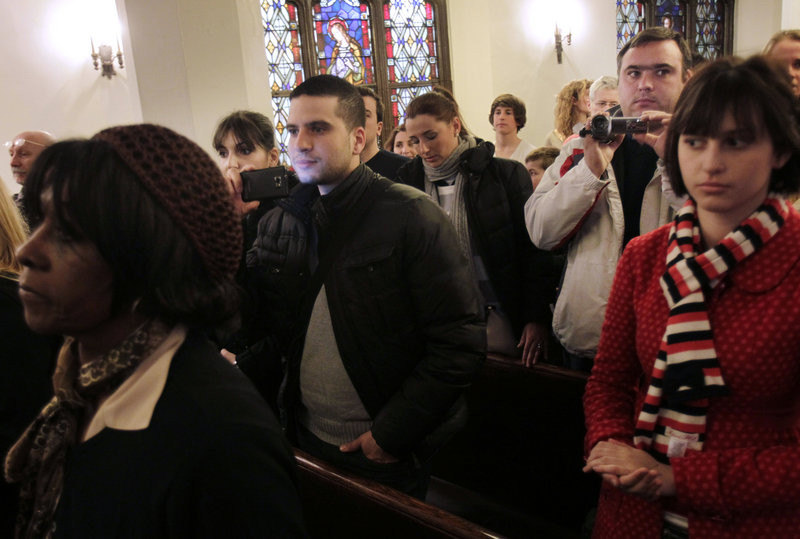NEW YORK – The stern warning issued from the pulpit was directed at the tourists – most of whom had arrived late – a sea of white faces with guidebooks in hand. They outnumbered the congregation itself: a handful of elderly black men and women wearing suits and dresses and old-fashioned pillbox hats.
“We’re hoping that you will remain in place during the preaching of the Gospel,” a church member said over the microphone at this Harlem church on a recent Sunday morning. “But if you have to go, go now. Go before the preacher stands to preach.”
No one left then. But halfway through the sermon, a group of French girls made their way toward the velvet ropes that blocked the exit. An usher shook his head firmly, but they ignored him and walked out.
The clash between tourists and congregants plays out every Sunday at Mother African Methodist Episcopal Zion Church, the oldest black church in New York state. It’s one of many Harlem churches that have become tourist attractions for visitors from all over the world who want to listen to soulful gospel music at a black church service.
To preserve the sanctity of the service, pastors struggle to enforce strict rules of conduct. But the reality is that these visitors are often filling church pews that would otherwise remain empty – and filling the collection basket with precious dollar bills.
“Our building is in need of repair,” church member Paul Henderson said after the service. “We need assistance. They’re helping to sustain us.”
The rules are simple enough: No photography, no flip-flops, no exiting during the sermon. They are printed on pamphlets and multilingual signs and announced at the start of every service. But they are often ignored.
Some pastors quietly manage the crowds by requiring a written confirmation of guests from tour operators, refusing walk-in visitors. Some churches provide assigned seating for tourists, while others demand a list specifying which countries the tourists are from and whether they speak English.
The Rev. Gregory Robeson Smith, Mother AME Zion’s pastor, refuses to work with tour operators. He doesn’t even like to use the word “tourist,” preferring instead to call them part of his “international congregation.” And he won’t turn anyone away.
“I refuse to commercialize the church worship experience,” he said. “You don’t pay people to experience the Lord, to come and pray. I think that’s unconscionable.”
Yet the tourists’ presence is undeniable. At Mother AME Zion, there were nearly 200 of them, overwhelming the congregation by at least 5 to 1.
The gospel tour industry has exploded since it was born in the early 1980s. On a busy summer Sunday, Harlem Spirituals, one of the oldest and largest tour operators, might run 15 full buses, said Erika Elisabeth, a company vice president.
Tickets can cost up to $55. Most churches get a cut of the profit. Others, like Mother AME Zion, make money by encouraging visitors to drop a suggested donation into the collection basket.
Without the tourists’ wallets, the organ might never get fixed. Mother AME Zion’s congregation is dying off, and there are very few young people left to fill the generation gap.
That’s not the case everywhere. Just around the corner is the thriving Abyssinian Baptist Church, arguably the neighborhood’s most popular tourist magnet, where visitors are often turned away because the pews are too full.
Celeste Lejeune, 16, from Paris, didn’t know anything about Mother AME Zion’s history as a stop on the Underground Railroad, or that its congregants once included Frederick Douglass and Harriet Tubman.
“I would like to just hear voices of people who live in Harlem, and see the atmosphere,” she said. “We don’t have music like this in France.”
That is precisely the sort of outlook that disheartens the congregation, who would like to believe the tourists have come to listen to the word of God, to be transformed by the power of Scripture.
But most of them are there to see a show – and a show they got. The pastor gave a dramatic sermon filled with historical and political overtones, his voice slowing to a low growl and then rising back up, cracking with the effort. The choir sang hymn after joyful hymn as the congregation clapped in time with the music.
If nothing else, the tourists got to step back in time for an hour or two. A time when ladies wore dresses and stockings to church and ushers with immaculate white gloves guided people to their seats.
At least with the tourists around, the place feels a little less empty on Sunday mornings.
Send questions/comments to the editors.



Success. Please wait for the page to reload. If the page does not reload within 5 seconds, please refresh the page.
Enter your email and password to access comments.
Hi, to comment on stories you must . This profile is in addition to your subscription and website login.
Already have a commenting profile? .
Invalid username/password.
Please check your email to confirm and complete your registration.
Only subscribers are eligible to post comments. Please subscribe or login first for digital access. Here’s why.
Use the form below to reset your password. When you've submitted your account email, we will send an email with a reset code.